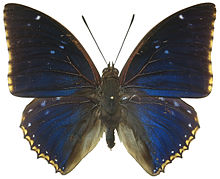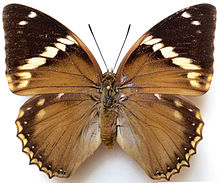Charaxes bipunctatus
Appearance
| Charaxes bipunctatus | |
|---|---|

| |
| Charaxes bipunctatus ugandensis male from CAR | |

| |
| Charaxes bipunctatus ugandensis female from Kenya | |
| Scientific classification | |
| Kingdom: | |
| Phylum: | |
| Class: | |
| Order: | |
| Family: | |
| Genus: | |
| Species: | C. bipunctatus
|
| Binomial name | |
| Charaxes bipunctatus Rothschild, 1894[1]
| |
| Synonyms | |
| |
Charaxes bipunctatus, the Two-spot Blue Charaxes, is a butterfly in the Nymphalidae family. It is found in Ivory Coast, Ghana, Nigeria, Cameroon, Gabon, the Republic of Congo, the Democratic Republic of Congo, the Central African Republic, Uganda, Sudan, Kenya and Tanzania.[2] The habitat consists of lowland evergreen forests and sub-montane forests at altitudes between 1,200 and 1,500 meters.
The larvae feed on Blighia - Blighia unijugata.
Description
A full description is given by Rothschild, W. And Jordan, K., 1900 Novitates Zoologicae Volume 7:287-524. [1] page 390 (for terms see Novitates Zoologicae Volume 5:545-601 [2])
Taxonomy
Charaxes tiridates group
the supposed clade members are
- Charaxes tiridates
- Charaxes numenes similar to next
- Charaxes bipunctatus similar to last
- Charaxes violetta
- Charaxes fuscus
- Charaxes mixtus
- Charaxes bubastis
- Charaxes albimaculatus
- Charaxes barnsi
- Charaxes bohemani
- Charaxes schoutedeni
- Charaxes monteiri
- Charaxes smaragdalis
- Charaxes xiphares
- Charaxes cithaeron
- Charaxes nandina
- Charaxes imperialis
- Charaxes ameliae
- Charaxes pythodoris
- ? Charaxes overlaeti
For a full list see Eric Vingerhoedt, 2013[3]
Subspecies
- Charaxes bipunctatus bipunctatus (Ivory Coast, Ghana, western Nigeria)
- Charaxes bipunctatus ugandensis van Someren, 1972 (Cameroon, Gabon, Congo, Democratic Republic of Congo, Central African Republic, western Uganda, western Kenya, southern Sudan, north-western Tanzania)
References
Wikimedia Commons has media related to Charaxes bipunctatus.
Wikispecies has information related to Charaxes bipunctatus.
- Victor Gurney Logan Van Someren, 1972 Revisional notes on African Charaxes (Lepidoptera: Nymphalidae). Part VIII. Bulletin of the British Museum (Natural History) (Entomology)215-264.[3]
External links
- Images of C. bipunctatus bipunctatus Royal Museum for Central Africa (Albertine Rift Project)
- Images of C. bipunctatus ugandensis Royal Museum for Central Africa (Albertine Rift Project)
- Charaxes bipunctatus ugandensis images at Consortium for the Barcode of Life
- African Butterfly Database Range map via search
